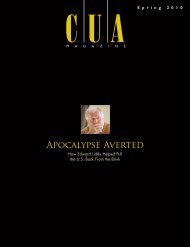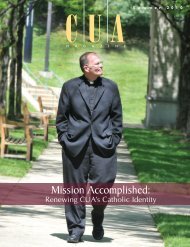Phenoms Under 40 - CUA Magazine - The Catholic University of ...
Phenoms Under 40 - CUA Magazine - The Catholic University of ...
Phenoms Under 40 - CUA Magazine - The Catholic University of ...
You also want an ePaper? Increase the reach of your titles
YUMPU automatically turns print PDFs into web optimized ePapers that Google loves.
E X P L O R A T I O N SRevolutionizingVaccines,PreventingEpidemicsAbove: Electron microscope reconstruction <strong>of</strong> abacteriophage T4 showing the knobs on its surface.Imagine it: A terrorist group sprays anthraxor pneumonic plague powder from a planecircling a major metropolitan area. Between80 and 100 percent <strong>of</strong> the infected populationdie horrible deaths unless they’retreated with antibiotics in the first severalhours or days.Sound far-fetched? <strong>The</strong> U.S. Centers forDisease Control and Prevention has, infact, put these two diseases on its list <strong>of</strong>those most likely to be used in a terroristattack. And “weaponized” powders <strong>of</strong>both diseases are still stockpiled in Russia,according to many published sources.<strong>The</strong>se facts help to explain why thedevelopment <strong>of</strong> a single vaccine againstboth these diseases would be crucial andtimely — and why the National Institutes<strong>of</strong> Health has given <strong>CUA</strong> biology Pr<strong>of</strong>essorVenigalla Rao a $2.5 million five-year grantto develop just such a vaccine.Rao and his research team feel theyhave reason to be optimistic: <strong>The</strong>y willbe building on NIH-funded research theyhave carried out in collaboration with theWalter Reed Army Institute <strong>of</strong> Research,in which they created vaccine formulationsthat proved highly effective in mice andrabbits.A single vaccine for these two diseaseswould fill a void. No vaccine exists forpneumonic plague, and the availableanthrax vaccine has limitations, such as ahigh frequency <strong>of</strong> side effects and the needfor six immunizations within 18 monthsand yearly boosters thereafter.If successful, the dual-disease vaccinewill set a precedent that is likely to leadto single vaccines that simultaneouslyimmunize against three, four or morediseases, according to the <strong>CUA</strong> pr<strong>of</strong>essor.“Dr. Rao has had an incredibly productiveresearch career, and is widely recognized asone <strong>of</strong> the predominant authorities in theareas <strong>of</strong> molecular biology, immunologyand associated applications such as vaccinedevelopment,” says Dr. Carl R. Alving, chief<strong>of</strong> adjuvant and antigen research for HIVvaccines at the Walter Reed Army Institute<strong>of</strong> Research, located in Rockville, Md.<strong>The</strong> <strong>CUA</strong> pr<strong>of</strong>essor’s vaccine researchwas born out <strong>of</strong> his 29-year quest to understandthe molecular machinery and lifecycle <strong>of</strong> a harmless virus called bacteriophageT4. In the process, Rao discoveredthat the 1,025 infinitesimal knobs on theouter mantle <strong>of</strong> these viruses could beused to develop novel vaccines. <strong>The</strong> ideaoccurred to him to attach proteins <strong>of</strong>multiple diseases such as plague andanthrax to these knobs — a bit likeattaching campers to automobile trailerhitches.When such a specially prepared bacteriophageT4 is injected into a person, hisor her immune system would recognizethe attached anthrax or plague proteins asforeign particles and elicit the production<strong>of</strong> antibodies to neutralize infection. <strong>The</strong>person’s immune system would thus beprimed to attack and neutralize anthraxand plague without actually being infectedby the bacteria that cause these diseases.Rao and his team aim to create thedual-disease vaccine and test its efficacyon rhesus monkeys by 2014. It is hopedthat the first phase <strong>of</strong> FDA clinical studiesfor use on humans will follow.Meanwhile, the pr<strong>of</strong>essor’s devotionto understanding the basic biology <strong>of</strong> thebacteriophage T4 remains strong. Thissummer he has received a $1 million grantfrom the National Science Foundationand expects additional grants from theNIH — all to continue studying themicroscopic organism’s structure andfunctions.— R.W.S U M M E R 2 0 0 9 9









